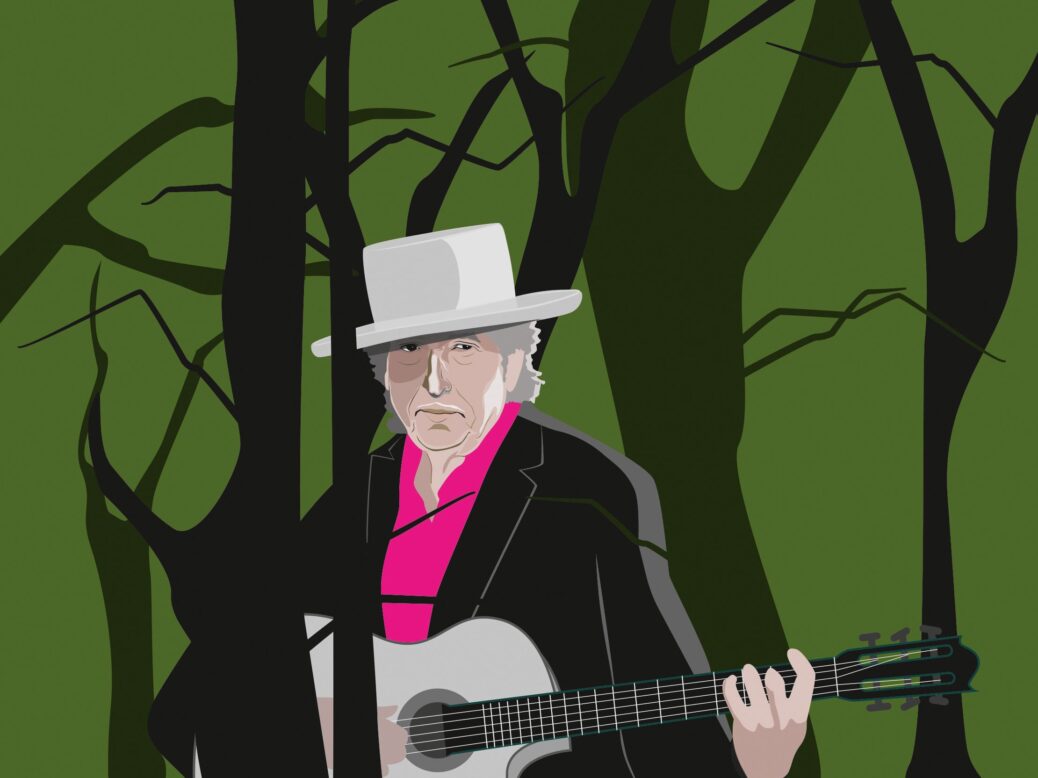
Thirty-six shows into his 1990 world tour, Bob Dylan stood onstage in the Hamburg Stadtpark. Balancing on his head was a weird, oversized, 1950s-style biker cap, and on his face an unruly fuzz of brown beard. Dylan was at the tail-end of his forties, but not in the way that Thurston Moore was in the late 2000s, still floppy-haired like a teenager; nor in the way that Prince was at the 2007 Super Bowl, somehow manipulating meteorological forces to synchronise a downpour with his monumental performance of “Purple Rain”. Though still a compelling performer, Dylan had lost much of his raw power. A life of music had failed to keep him forever young. Rather, he resembled Robert Shaw as Quint in Jaws – a man out of time who seemed to have been born pre-weathered, disappointed, weary of a world gone wrong.
“In case you wonder what happens to people like me, here’s a song that kinda tells you about it,” he said into his microphone. Then, with a clang of his guitar, he began to sing: “He’s just an old rock’n’roller playing music in a backstreet bar…” It wasn’t one of his. It was “Old Rock’n’Roller” by a country group called the Charlie Daniels Band. The song tells the story of an ageing musician who “sings a little flat”, plays bad guitar, had a hit record in the 1960s but “never could make it happen again”. Here was Dylan playing in a 4,000-capacity open-air venue filled with loyal fans, his recording career briefly back on track with the previous year’s intermittently brilliant Oh Mercy. Yet he related to Daniels’s tragic hero, the failed barroom musician: “Sometimes at night when the music and the crowd is having fun,/He steps up on the mic with a gleam in his eye… Then the sweet bird of youth just flies away.”
It’s not hard to see why. Dylan, so consistently good between 1962 and 1975, had missed the mark more often than he’d hit it for 15 years. Under the Red Sky, an underwhelming record released later on in 1990, would do little to redress the balance. Like the rest of us, he didn’t know that he was just seven years shy of another hot streak with records such as Time Out of Mind and Rough and Rowdy Ways that would eclipse his canonical 1960s work in terms of depth and power. So, on the road or in the studio, he contented himself with kissing joy as it flew, whenever it came near enough, then letting it fly away. You hear those moments on his spottiest albums: the clear-sighted lyrics of “Every Grain of Sand” on 1981’s Shot of Love, or “Brownsville Girl” on 1986’s Knocked Out Loaded, one of his most complex narrative ballads.
Deep-diving Dylan fans search out these moments of mastery on his worst records and at his shows, which have long been patchy. And if we’re honest, this is surely what we do even when we’re listening to his best songs. Dylan’s great contribution as a musician resides in his inconsistency. Even at their most expansive and profound, his lyrics present a multitude of voices, images and cultural references – some of which fall flat. (Think of Jesus’s unwarranted cameo in the girl-I-left-behind ballad “Red River Shore”.) It is the power of his performances and the logic of the melodies – often a riff on a familiar pop template – that suggest the presence of a cohesive message. Yet what that message might be is largely left for the listener to decide.
This vagueness, this imprecision, is what makes Dylan so endlessly rewarding. Songwriters like Leonard Cohen articulately present their subjective world-view. Dylan, who says everything and nothing at once, gives us whole worlds to explore – worlds that are limitlessly mysterious and contain the good alongside the bad. And he continues to do so, long after his sweet bird of youth has flown.
This article appears in our “Who is Bob Dylan?” series
This article appears in the 19 May 2021 issue of the New Statesman, In defence of meritocracy






